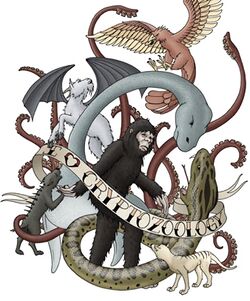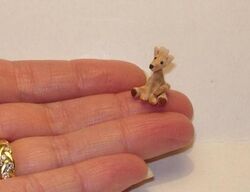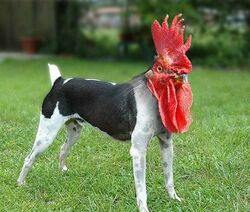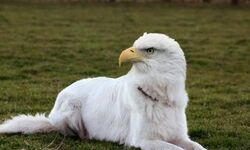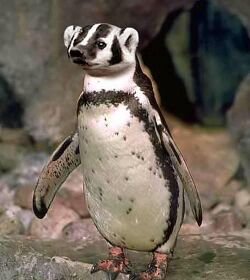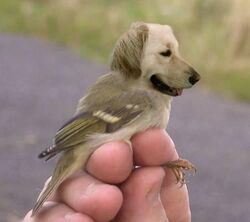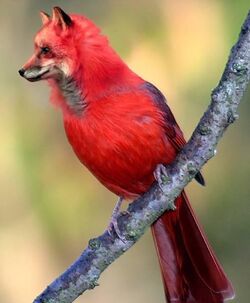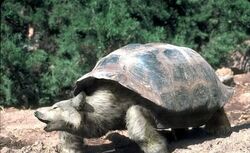Recent developments in Crypto-Zoology
| “ | Absence of evidence is not evidence of absence | ” |
Crypto-zoology is most commonly associated with tabloid favourites such as the Yeti/Bigfoot/Sasquatch, the Loch Ness Monster and the interesting Belgian. As such, many people have dismissed the discipline as nonsense, and yet within the last twenty years, largely unheralded by the press, crypto-zoologists have uncovered several important new species and three entirely new classes of vertebrates (Avian-mammals, Avian-reptiles and Repto-mammals.)
Previously unknown Mammals
Pygmy Giraffe
Among the smallest of all mammals the Pygmy Giraffe lives in the lush grasslands of the Okavango delta, Botswana. Standing a mere five inches tall, the pygmy giraffe uses its long neck to reach the very tips of the grass plants, where the most succulent seeds are unavailable to other pygmy African mammals such as the micro-buffalo and the pico-kudu.
Pygmy Giraffes have leathery lips and tongues to allow them to deal with the toughest of vegetation. They also have unique, paisley markings that allow them to hide among crowds of hippy tourists when threatened by meerkats.
It is unknown whether the Pygmy Giraffe is endangered as they have proven to be unusually difficult to count. However, most authorities agree that the pre-colonial population density of 25 per square metre is far higher than at the present day.
Sabre-toothed Donkey

Few people would choose to ride the sabre-toothed donkey were it to make an appearance on the beach, and they would be right to be nervous. Though superficially similar to the standard donkey, the sabre-tooth can be easily distinguished by an expert by a small white patch on the tip of each ear, and by fourteen inch tusks protruding from both top and bottom jaws.
Sabre-toothed donkeys are vegetarian by nature but find grazing the dusty savannah difficult due to their dentistry. In practice, therefore, most sabre-teeth subsist on a diet of lions.
Like rodents, sabre-toothed donkeys have uncapped roots to their teeth, allowing them to grow throughout their lives. This ensures that the sabre-tooth may lose a tooth during the intense rutting season, and yet live to re-grow the tooth for the following year. In captivity, however, without veterinary dental treatment, the bottom incisors are prone to grow in a curve, eventually drilling into the top of the skull and killing the sabre-tooth.
Avian mammals
Cuckoo Kangaroo
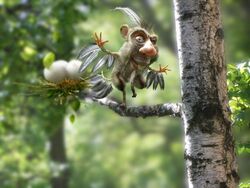
This alliterating Australian avian-mammal takes advantage of the power of flight to have its young raised in a more habitable environment than the adult would usually choose to inhabit.
In the spring, the cuckoo-kangaroo flies to a well-watered territory that is often thousands of miles from its own. Here it waits patiently in a gum-tree, looking for a suitable host-marsupial. When the host has been identified, the cuckoo-kangaroo will patiently follow until the animal rests before laying a single egg in the host’s pouch.
Once the egg hatches, the young cuckoo-kangaroo will swiftly evict any ‘siblings’ before settling down to literally suck its ‘mother’ dry. When the host-mother dies (usually after four or five weeks) the Joey will eat the internal organs before emerging as a fully fledged adult.
The cuckoo-kangaroo is the state bird of New South Wales and the state mammal of Victoria
Rhode Island Ridgeback
The Rhode Island Ridgeback (Canis Cluckensis) has been found in both North America and Zimbabwe suggesting that at one point this stunning avian-mammal must have had a much wider range. Farmers on both sides of the Atlantic have learned to value the Rhode Island Ridgeback both for its faithful stock-guarding abilities and for its welcome egg-production.
The remaining wild populations have been little studied but breeding appears to begin at around four years of age (common in Rhode Island) and the bitch generally produces a clutch of around six eggs. Both parents then take turns sitting on the eggs and hunting the savannah, running down herds of groundworms, or pecking among the dry grass for nutritious seeds.
After six weeks the puppies are ready to take their first and only flight. One by one, the young stand on the edge of the nest, flapping their paws before plummeting through the acacia thorn that has protected them since hatching. About sixty percent of the puppies survive this brutal initiation into the adult world after which they begin to associate themselves into a juvenile pack. Soon after their first corn-hunt begins in earnest.
Walrot
The Walrot (or Carpenter's Parrot) is an Arctic avian-mammal that survives despite one of the largest commutes in the Animal Kingdom. Unlike most Arctic and Antarctic species, the Walrot has not adapted to ground nesting, and thus one parent must tend the nest (typically in a North African Jacaranda tree) while the other hunts for food in the waters around Greenland. The hunting parent is reputed to eat three to four times its own body-weight of crustaceans before attempting to fly home. Once the returning Walrot regains its nest it has, of course, consumed 80% of the calories which it had so carefully accrued. It regurgitates what is left in its stomach along with one of its kidneys - a process which crypto-zoologists have christened uber-barfing. The other parent departs while the exhausted returnee begins a long wait until it too can return to the pristine Greenland waters.
Inuit tradition insists that a boy must wear a necklace of Walrot tusks before being initiated into the tribe as a fully fledged man. The usual Inuit mode of hunting is to scout out a particularly abundant source of shellfish and simply wait until the Walrot is too heavy to take off. Once one Walrot has been caught and detusked, the entrails are stretched out across the rocks to attract more Walrot which are, of course, notoriously cannibalistic.
Ethiopian Eagle Hound
The fastest of all flightless avian-mammals, the Ethiopian Eagle-Hound (Canis Aquila) has a razor-sharp beak and even sharper eye-sight. The eagle-hound is a lone hunter mostly found on the rocky fringes of the Ethiopian highlands. Though opportunistic its favourite prey is people and the Eagle-hound will hide in a cave or thicket until a herd of Afar tribesmen come into view. It then accelerates from a standing start to forty miles an hour in less than fifteen second, heading directly for the centre of the herd. Once the tribesmen have been panicked the Eagle-hound selects a young, preferably lame individual which it will swiftly despatch with a single flick of its wickedly curved beak, before then selecting another victim which it will chase down and kill in a similar manner. The second victim is consumed in its entirety before the smaller prey tribesman is dragged back to its lair where it will feed the eagle-hounds hungry puppies, and its bones will provide stimulus material for the pups' artistic development.
Penger
The Penger had barely been discovered before its population went into a steep decline due to persecution from man. Many Penger are dug out of their setts and forced to fight terriers for the amusement of passing scientists. The scientists have found Penger-baiting not only passes long Winter months snowed-in at research stations, but provides a lucrative side-line in on-line betting. At the same time the Penger is blamed by Antarctic fishermen for passing Tuberculosis to herring. Despite evidence that Penger populations are easily inoculated with baited fish, the British Antarctic Territories government has recently launched a plan to gas the remaining population, as it is thought that this will be "more of a laugh".
There are at least three different sub-species of Penger, the Rock-hopper Penger which nests along the Arctic shore, the Jackass Penger (Pengerium Knoxvillus), and the Emperor Penger which marches almost eighty miles inland to nest on the howling ice-plains in an apparently suicidal attempt to gain sympathy and/or a movie-contract.
Mammalian finches
There are now known to be a minimum of 400,000 species of mammalian finch occupying various ecological niches around the world, many of which can only be distinguished by experts, or their mothers. Of these species perhaps the two best loved are the Dog finch and Reynard's finch, both of which inhabit the islands of Indonesia.
Under most threat is the Reynard's finch, hunted for its feathers by local tribesmen and, unaccountably, by mounted British tourists to the accompaniment of bugle calls and shouts of "Tally-ho".
The Dog finch is small enough to fit easily into the palm of a hand, or into one's mouth. At one point flocks of millions could be seen stripping the fields of Indonesia bare of grain. Now, however, the Dog finch may well be extinct in the wild and is seen only in captivity where it is kept for its tuneful woof and its piquant taste.
Avian Reptiles
Vietnamese Snapping-Duck
The swamps of Vietnam are not short of unpleasant surprises for the unwary tourist; poisonous spiders, giant constricting snakes, bad exchange rates, but those unwary enough to swim in the warm, murky waters of the Mekong headlands would do well to avoid the Snapping-Duck.
Hatching after a mere four-day incubation, Snapping-Ducklings subsist on insects and other Snapping-Ducklings for the first two years of their lives. However, as adolescence approaches swarms of Snapping-Ducklings congregate on the river bank, waiting seemingly un-breathing, for a chance victim. The slightest vibration in the water may draw the attention of part of the swarm who launch themselves into the water with a blood-curdling quacking, biting at every movement. A single droplet of blood will draw in the rest of the swarm and the victim, no matter its size, will be reduced to a skeleton in moments.
It has been suggested that the one factor holding back the success of the Snapping-Duck is its sheer aggression. As swarms near a hundred it is inevitable the one Snapping-Duck will inadvertently bite another, causing a swarm attack in which eventually the entire swarm will eat itself.
Parragator
Haunting the bayou of Louisiana, the Parragator is also an ambush predator. Flocks of Parragagators of anywhere up to six thousand have been seen blackening the skies above the Sabine River, and local farmers know to their cost to keep stock indoors during the Autumn when the Parragator's natural prey, muskrat, are scarce. Louisiana folklore abounds in stories of entire herds of cattle being eaten in the course of an afternoon, and more than one ranching family has disappeared during the Parragator mating-season.
During the day, most Parragators are active hunters but there is some evidence to show that small numbers of Parragators have adapted their behaviour to hunt in the dusk and early evening. These almost-nocturnal Parragator have abandoned the flocking instinct to seek out individual prey which the approach from behind, biting off a rear-foot with jaws that can deliver a crunching 5,000 lbf (22 kN) bite. Rather than attempt to eat the animal, the single Parragator merely licks up the blood, occassionally biting off another limb until the victim collapses, at which point its Carrotid artery is severed and the Parragator will feast until it can drink no more. These so-called 'Vampire'- Parragators are objects of great fear in the backwaters of Baton Rouge .
Repto-Mammals
Toryote
The Apache have long told of a fearsome, if slow moving, hunter of the Chaco canyon, but until 2006 this was dismissed as "just another peyote-fuelled red-skin hallucination". However, naturalists hoping to photograph a Mountain lion left remote cameras along a three-mile ridge and revealed this single image to the world.
Taken at the height of midday, the image appears to show the Toryote in the act of hunting, though this cannot be confirmed. Apache legend insists that the Toryote lives underground for many years, emerging only after intense rainfall to eat its fill of jack-rabbits and mate before returning to the soil to lay eggs. A spokesman for the Jicarilla Apache said "Naʼisha Ypenta, nagai a acharin."
| Featured version: 30 March 2012 | |
| This article has been featured on the main page. — You can vote for or nominate your favourite articles at Uncyclopedia:VFH. | |
